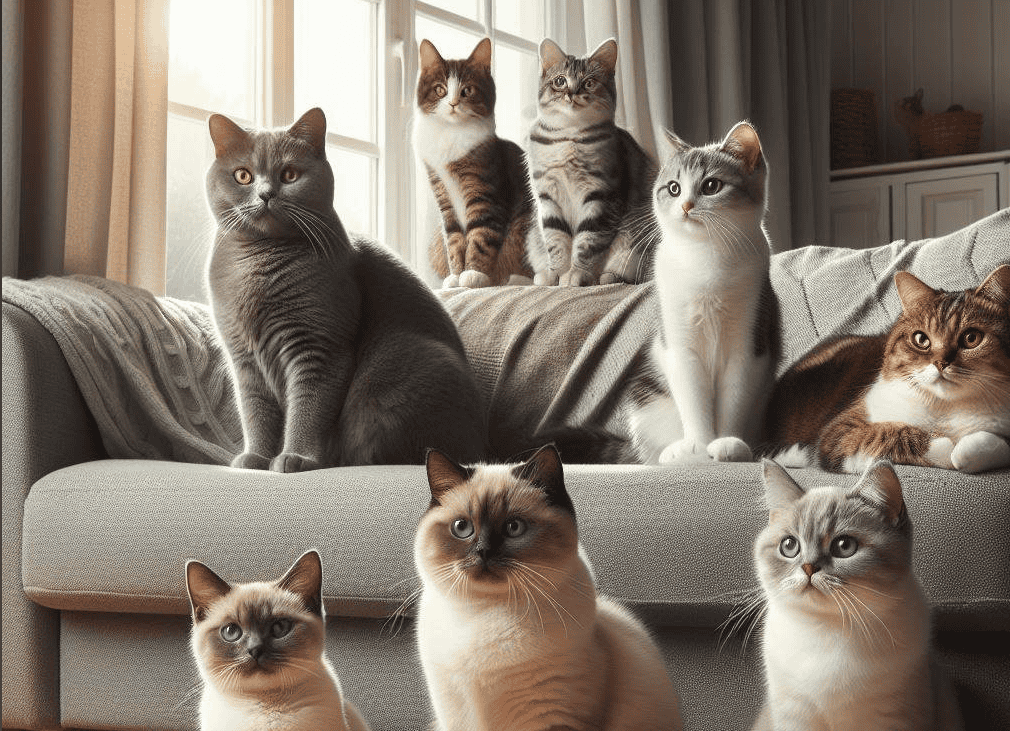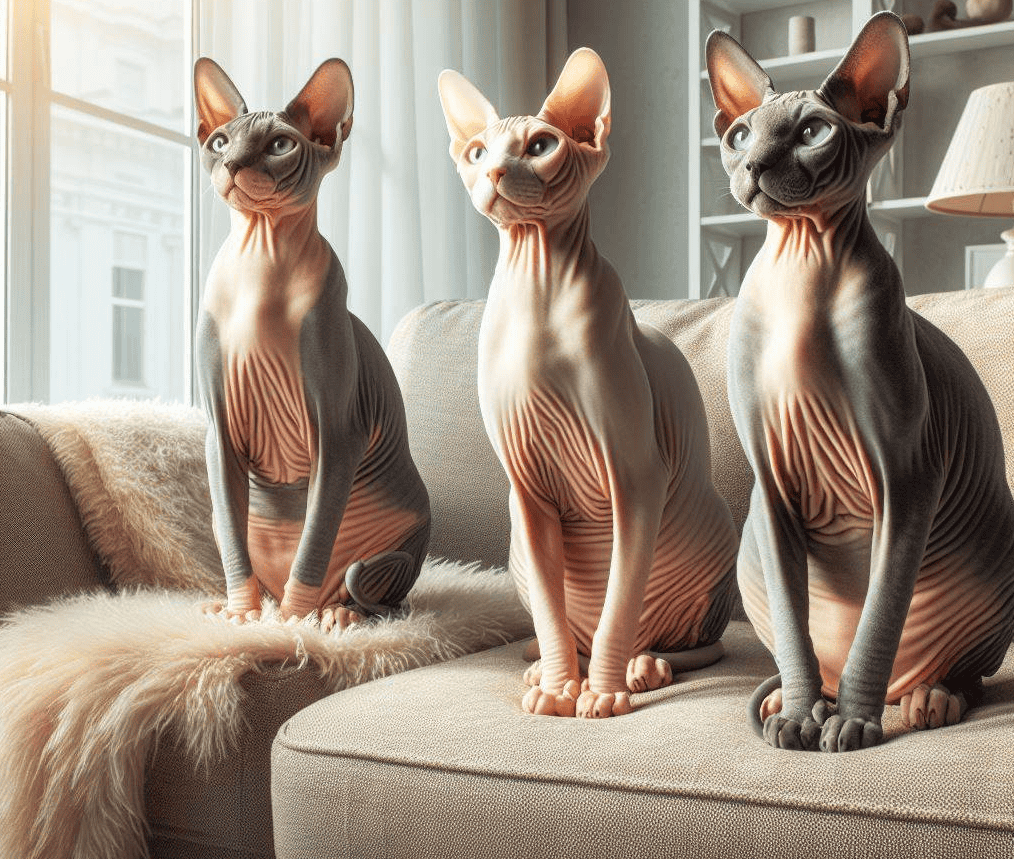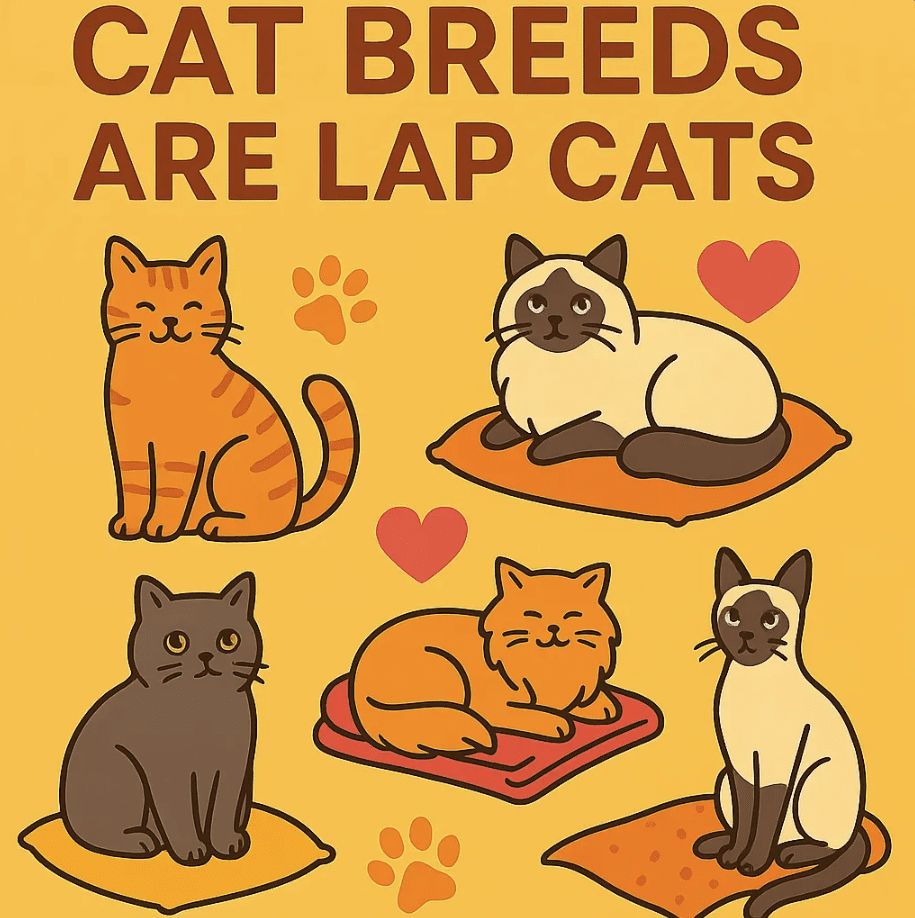Low-shedding cat breeds are great for minimizing allergic reactions and reducing maintenance. Cats with shorter hair or unique coat properties are often best for allergy sufferers. Opting for cats that don’t shed much can help maintain a cleaner home and they will have their own specific needs and personality traits.
Have you ever hesitated to hug a purring kitty – even though your heart yearns for a warm cuddle?
Your allergies might kick in and turn that moment of joy into a sneezing frenzy. 🤧
Or perhaps, the thought of cat hair adorning every fabric of your clothing is a deterrent?
I know the feeling all too well – Doofy sheds a lot and I always wear black clothing (whenever I need to cuddle him) to make it easier to lint roll his white furs. 😁
But, let me tell you, there’s a sliver of hope for those of us who love these feline friends.
In the world of cats, there are indeed some that grace us with minimal grooming demands.
They are the low-shedding cat breeds, the minimal-shedding cat breeds, the best cats for people with allergies, and simply, the cats that do not shed much.
They offer a glimmer of possibility for us to live harmoniously with our feline companions without a lint roller forever in hand.
Identifying the right cat breed can be a saving grace for our homes, our clothes, and our sinuses.
Doing so will allow us to enjoy the quiet company of a cat curled up on the couch or the playful antics of a furry friend without the usual cascade of fur.

Understanding Cat Allergies and Fur Shedding
Before bringing your feline friend home, it’s good to know that all adorable felines, regardless of breed, produce Fel d 1 – the primary allergen responsible for triggering allergic reactions.
This protein, prevalent in cat skin, saliva, and dander, tends to cling to fabrics and furniture around the house.
Opt for hypoallergenic cats if you wish to have a more manageable allergen level in the household.
And if you are someone fond of minimalist cleaning routines, you might want to lean toward cats that are low maintenance.
To ensure a harmonious living space, it is recommended to integrate practices such as frequent hand washing post-cat cuddles, employing lint rollers, and maintaining an environment bolstered with HEPA filters to trap dander.
Regular grooming routines for the cats are also a staple advice for lessening the allergenic impact.
Cohabitating with feline companions is about adapting to their personalities and lifestyles. Discovering the perfect match entails balancing your allergy concerns with the maintenance needs of these loving pets.
Which Cats Don’t Shed: Examining Hairless and Low-Shedding Breeds
Through my research, I’ve learned that while no cats are entirely hypoallergenic, certain breeds garner attention for their minimal shedding, potentially making them top cat breeds that don’t shed much and are prized by allergy sufferers and tidy home enthusiasts alike.
Hairless felines, like the enigmatic Sphynx, stand out in the crowd for their obvious lack of fur.
The allure of the Sphynx goes beyond its unique look; as it turns out, this breed’s personality is as notable as its appearance.
While these cats do produce the Fel d 1 allergen, their lack of fur means less dander floating around to stir up your allergies.
- Sphynx – The affectionate extroverts of the cat world, beloved for their clingy nature.
- Cornish Rex – With their wavy fur and slender bodies, they shed very little, requiring less grooming.
- Siamese – Noted for their striking blue eyes and a sleek, short coat that sheds minimally.
- Russian Blue – This plush-coated breed is known for its hypoallergenic qualities and sheds less.
- Bengal – While they might look wild, the Bengal’s pelt-like coat keeps shedding to a minimum.
Breed |
Coat Type |
Shedding Level |
Personality Traits |
Maintenance Needs |
|---|---|---|---|---|
| Sphynx | Hairless | None | Affectionate, Energetic | High for Skin Care |
| Cornish Rex | Curly, Short | Minimal | Playful, Adventurous | Relatively Low |
| Siamese | Short, Fine | Low | Social, Vocal | Moderate |
| Russian Blue | Dense, Short | Low | Shy, Gentle | Low |
| Bengal | Short, Dense | Low to Medium | Active, Intelligent | Moderate |
These breeds should top your list for their minimal shedding and unique characteristics if you are (seriously) considering getting a feline companion into your home.
From the engaging eyes of a Siamese to the exotic allure of a Bengal, these breeds all have their distinct charm.
One thing’s for sure: investing in one of these cat breeds that don’t shed will help keep your home fur-free and your sneezes at bay!
Is There Such a Thing as a Completely Hypoallergenic Cat?
The short answer is, unfortunately, no.
While many breeds are touted to be the best cats for people with allergies, it is essential to understand the role that the Fel d 1 protein plays in triggering allergic reactions.
Let’s delve into why some non-shedding cat breeds are preferred and how they may help those with sensitivities.
The Myth of Hypoallergenic Cats
Despite common claims, the concept of fully hypoallergenic cats is more myth than reality.
All cats produce the Fel d 1 allergen – no breed is entirely free from potential allergens.
However, some breeds have become popular for their minimal shedding qualities, which can deceivably give the impression of being ‘hypoallergenic’.
The Role of Fel d 1 Protein in Cat Allergies
Fel d 1 is the main allergenic protein that cats secrete through their skin, saliva, and even urine.
This protein readily latches onto the fur and dander of our fluffy companions, which is subsequently spread around as they shed.
Since all cats produce this protein to some degree, there’s no avoiding it entirely.
How Low-Shedding May Help
While it’s clear that no cat is hypoallergenic, selecting a breed that exhibits non-shedding characteristics could be a game-changer for allergy sufferers.
Low-shedding may reduce the frequency and amount of allergens dispersed into the environment, thus lessening the potential for an allergic response.
I’ve found that some cats receive more endorsement from allergic individuals than others.
For instance, the Sphynx, with its near absence of hair, and the Russian Blue, with its infrequent shedding cycle, are often suitable for being more compatible with those prone to allergies.
To give you a clear view, here’s a table highlighting some favored low-shedding breeds along with their shedding patterns and potential for allergen reduction:
Cat Breed |
Shedding Frequency |
Potential for Allergen Reduction |
|---|---|---|
| Russian Blue | Once or twice a year | Higher |
| Sphynx | Minimal to none | Higher |
| Cornish Rex | Low | Moderate to high |
| Siamese | Moderate | Moderate |
While I have outlined some options (as far as hypoallergenic cats are concerned), it’s recommended to spend time with a cat before bringing one into your home—this will help ensure that your new cat is a good match for your allergy needs.

Sphynx and Other Hairless Cats
When we talk about cats ideal for individuals seeking feline companions without the concern of shedding, hairless cats are often at the forefront of the conversation.
They stand out as hypoallergenic cats that cater to those with allergies or simply want a cleaner living space.
Let’s delve into the unique world of these extraordinary breeds that have a special place in the hearts of many due to their minimal shedding attributes.
The Unique Needs of Hairless Cat Breeds
Hairless cat breeds have characteristics that set them apart from their furry counterparts, demanding specific care routines.
Exposure to sunlight can pose a risk to their skin, making sunscreen a surprising but essential part of their care.
Equally, their lack of fur makes them susceptible to cold, often requiring warm clothing or blankets to maintain a comfortable body temperature.
As someone who deeply appreciates these special breeds, I am always mindful of their dietary requirements which are important in managing their skin’s oil levels.
Sphynx Cats: A Popular Hairless Option
The Sphynx is a beloved member of the hairless cat family, known for its endearing personality and striking appearance.
These cats are often the first choice for potential cat owners searching for breeds that fall under the category of which cats don’t shed.
Their care includes regular bathing to remove excess oil and monitoring their diet to keep their skin healthy.
Despite their lack of fur, they make up for it with their immense warmth, both in body temperature and affection.
Donskoy and Peterbald: Other Hairless Varieties
Exploring further, the Donskoy and Peterbald breeds offer an alternative for those enamored by the Sphynx but are looking for something slightly different.
These breeds share similar needs, such as staying out of harsh weather conditions and receiving proper skincare from their human companions.

The Donskoy’s muscular body and Peterbald’s svelte figure are sure to captivate anyone who lays eyes on them.
Breed |
Average Lifespan |
Personality Traits |
Care Requirements |
|---|---|---|---|
| Sphynx | 8-14 years | Affectionate, Energetic | Regular bathing, Warm environment |
| Donskoy | 12-15 years | Intelligent, Playful | Protect from cold, Frequent bathing |
| Peterbald | 12-15 years | Social, Curious | Skincare, Diet monitoring |
These hairless beauties epitomize elegance and a strong connection with their human companions.
While their care might demand more attention and time, embracing a hypoallergenic cat like the Sphynx, Donskoy, or Peterbald can be a uniquely rewarding experience.
Their affectionate nature and engaging personalities make them fitting for anyone searching for a loyal and less shedding pet companion.
Caring for Cats That Don’t Shed Much
With low-shedding cat breeds, you can bask in their companionship without the usual furry tumbleweeds rolling across your living room floor.
But let’s not forget – these minimal shedding cat breeds are not a free pass from grooming and care.
Cats that are low maintenance relatively speaking still require attentiveness to thrive. Here’s how I ensure my feline friends stay well-groomed and healthy:
Grooming Tips for Low-Shedding Cats
Grooming is more than just keeping your cat looking good—it is also a health check in disguise.
Regular brushing helps distribute natural oils across the skin, keeps the coat shiny, and, importantly, reduces whatever little shedding there is.
Even hairless breeds can benefit from a gentle wipe to remove excess oil.
I’ve found that a weekly routine does wonders, and during shedding season, a little extra effort can keep their coat in perfect condition.
Additionally, specialty shampoos designed for delicate skin or hypoallergenic needs can help minimize dander or allergens.
Regular Vet Check-ups
It can be tempting to cut corners with cats that don’t seem to need much, but yearly check-ups with the vet are a must.
These visits are the perfect time to ensure nothing is amiss with their skin, ears, and overall well-being.
You should schedule your appointments with your vet regularly and always look out for any unusual behaviors that might warrant a trip to the doctor in between.
Managing Shedding in Low-Shed Cats
Believe it or not, even cats that shed minimally can still produce enough loose fur to require management.
Strategic brushing with the right tools can remove that loose fur before it scatters.
Investing in a good HEPA filter vacuum also helps to keep any allergens at bay, ensuring your home remains as pristine as your cat’s coat.
Final Thoughts
Potential cat owners should understand that, despite the allure of minimal shedding cat breeds, each feline friend will require dedicated care.
This includes consistent grooming and check-ups to foster a thriving environment.
There are many options for those who yearn for the companionship of a furry friend but seek to minimize the sneezes and vacuuming.
With a thoughtful approach to selection and care, allergy sufferers and neatniks alike may find a cat that graciously spares their tissues and lint rollers.
FAQ
Q: What are the unique needs of hairless cat breeds?
A: Hairless cat breeds like the Sphynx require regular bathing to remove the buildup of oils on their skin and protection from extreme temperatures.
They also need consistent and engaging interaction with their owners to satisfy their social nature.
Q: How often do hairless cats need to be bathed?
A: Hairless cats typically need to be bathed more frequently than their furry counterparts, usually every one to two weeks, to manage the natural oils on their skins and prevent skin problems.
Q: What grooming is necessary for low-shedding cats?
A: Low-shedding cats still require grooming to maintain their coat and skin.
This includes regular brushing, occasional baths, and nail trimming.
It’s also important to have their ears checked and cleaned as needed to prevent infections.
Q: Does less shedding mean a cat is low maintenance?
A: Not necessarily.
While less shedding may imply less hair to clean up, all cats require a certain level of care, including feeding, grooming, playtime, and veterinary checkups, regardless of their shedding levels.
Q: Can low-shedding cats still affect people with severe allergies?
A: Yes. Low-shedding cats can affect people with severe allergies because they produce the same allergenic proteins as other cats.
Each person’s sensitivity to allergens varies, so those with severe allergies should spend time with a cat before adopting to assess their reaction.
Help Reads
- https://be.chewy.com/behavior-breeds-cat-breeds-that-dont-shed/
- https://lacvets.com/blog/5-cat-breeds-that-dont-shed/
- https://bondvet.com/b/cat-breeds-shed-the-least

In her previous life, Lisa traveled extensively, both for work and leisure. After the pandemic struck, Lisa locked up her luggage and adopted a cat ever since.
Lisa is now an avid cat lover, she devotes most of her free time serving as butler to her adorable feline at home. When she is not with her cat, she can be seen using her phone sourcing for the latest cat supplies online.

